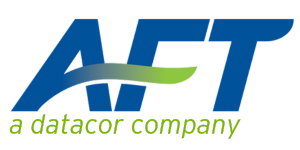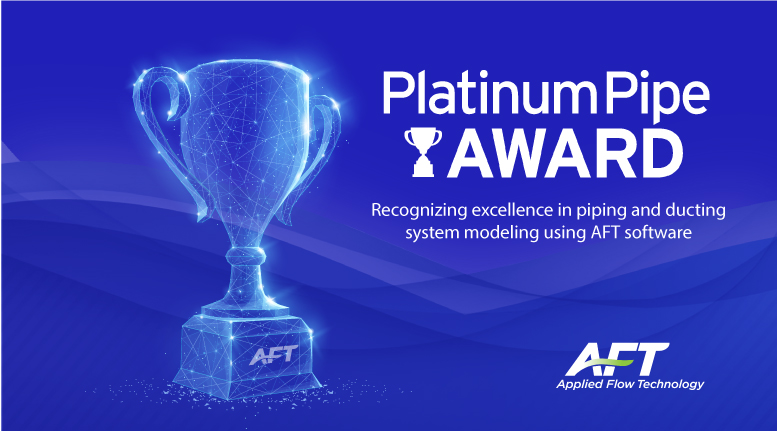AFT President to Present Three Papers at ASME Pressure Vessels & Piping (PVP) Conference
COLORADO SPRINGS, Colo., USA, April 19, 2018 -- The ASME 2018 PVP Conference promises to be the outstanding international technical forum for participants to further their knowledge-base by being exposed to diverse topics, and exchange opinions and ideas both from industry and academia in a variety of topics related to Pressure Vessel and Piping technologies for the Power and Process Industries.
AFT President Trey Walters will present the following three papers at the conference in Prague:
1. WHEN THE JOUKOWSKY EQUATION DOES NOT PREDICT MAXIMUM WATER HAMMER PRESSURES
Co-author: Robert A. Leishear, Ph. D., P. E., Leishear Engineering, LLC., author of Fluid Mechanics, Water Hammer, Dynamic Stresses and Piping Design
ABSTRACT
The Joukowsky equation has been used as a first approximation for more than a century to estimate water hammer pressure surges. However, this practice may provide incorrect, non-conservative, pressure calculations under several conditions. These conditions are typically described throughout fluid transient text books, but a consolidation of these issues in a brief paper seems warranted to prevent calculation errors in practice and to also provide a brief understanding of the limits and complexities of water hammer equations.
To this end, various issues are discussed here that result in the calculation of pressures greater than those predicted by the Joukowsky equation. These conditions include reflected waves at tees, changes in piping diameter, and changes in pipe wall material, as well as frictional effects referred to as line pack, and the effects due to the collapse of vapor pockets. In short, the fundamental goal here is to alert practicing engineers of the cautions that should be applied when using the Joukowsky equation as a first approximation of fluid transient pressures.
2. A PROPOSED GUIDELINE FOR APPLYING WATERHAMMER PREDICTIONS UNDER TRANSIENT CAVITATION CONDITIONS PART 1: PRESSURES
Co-authors: Matthew Stewart, P.E. and Greg Wunderlich, P.E., both of AECOM (and customers of AFT) and Erin Onat, Applied Flow Technology
ABSTRACT
Waterhammer analysis (herein referred to as Hydraulic Transient Analysis or simply "HTA") becomes more complicated when transient cavitation occurs (also known as liquid column separation). While standard HTA transient cavitation models used with analysis based on the Method of Characteristics show good correlation when compared to known test/field data, the great majority of test/field data are for simple systems experiencing a single transient. Transient cavitation in more complicated systems or from two or more independently initiated transients have not been validated against data.
Part 1 of this paper describes the various safety factors already provided by ASME B31.3 for pressure containment, provides criteria for accepting the results of HTA calculations that show the presence of transient cavitation, and makes recommendations where the user should include additional safety factors based on the transient cavitation results.
Situations are discussed where waterhammer abatement is recommended to reduce hydraulic transient pressures and forces, and for increasing confidence in HTA results in specific cases. The result is a proposed comprehensive and pragmatic guideline which practicing engineers can use to perform waterhammer analysis and apply pressure predictions to pipe stress analysis.
3. A PROPOSED GUIDELINE FOR APPLYING WATERHAMMER PREDICTIONS UNDER TRANSIENT CAVITATION CONDITIONS PART 2: IMBALANCED FORCES
Co-authors: Matthew Stewart, P.E. and Greg Wunderlich, P.E., both of AECOM (and customers of AFT)
ABSTRACT
Waterhammer analysis (herein referred to as Hydraulic Transient Analysis or simply "HTA") becomes more complicated when transient cavitation occurs (also known as liquid column separation). This complication is exacerbated when trying to predict imbalanced forces as this often involves comparing pressure times area ("PxA") forces at two locations (for example at elbow pairs). Whereas the pressure at each elbow location has increased uncertainty because of transient cavitation, the difference in PxA forces at elbow pairs involves subtracting one potentially uncertain pressure from another uncertain pressure. Exacerbating this uncertainty yet further, the existence of vapor in a liquid system can dramatically affect the fluid wavespeed and, hence, the timing of the pressure wave travel between two locations such as elbow pairs; so the pressure calculated at each location would not actually occur at exactly the same time.
This Part 2 discusses methods of accounting for uncertainty in HTA imbalanced force predictions due to cavitation. The criteria in this paper assume that cavitation in the HTA has been assessed and accepted per the criteria in Part 1 of this paper.
A guideline is proposed for accepting and applying such results and, in particular, makes recommendations on safety factors to use in pipe stress analysis for different cases. The specific recommendations depend on numerous factors including:
- Presence or absence of cavitation in hydraulically connected or isolated parts of the system
- If cavitation occurs, whether the peak forces occur before or after cavitation first occurs
- Size of the cavitation vapor volumes with respect to the computing volumes
- Use of point forces as a conservative substitute in place of potentially less certain elbow pair forces or the manual assessment of maximum envelope values for the force.
Situations are discussed where waterhammer abatement is recommended to reduce hydraulic transient forces, and for increasing confidence in HTA results in specific cases. The result is a proposed comprehensive and pragmatic guideline which practicing engineers can use to perform waterhammer analysis and apply imbalanced force predictions to pipe stress analysis.


